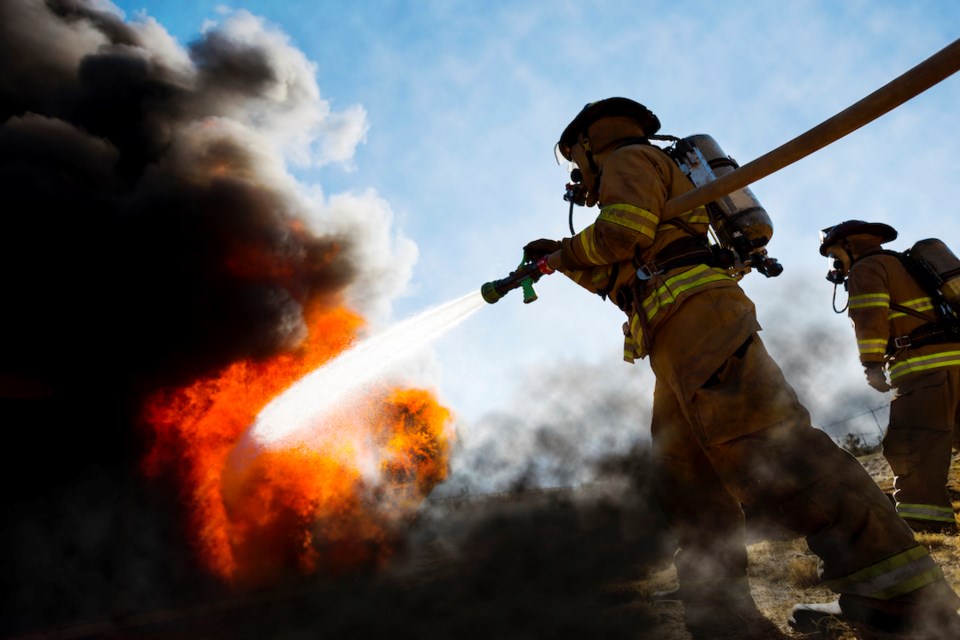If you ask Bill Higgs, it’s not a raging wall of fire homeowners need to worry about, it’s the embers thrown well ahead of a wildfire that hit a house and settle in a nest of combustibles, ripe for ignition. And those cedar hedges? Those need to go.
A former Sechelt fire chief of 26 years – 1990 to 2016 – Higgs is now working for the Sunshine Coast Regional District (SCRD), turning his well-practiced eye onto the homes of Coast homeowners, and letting them know how they might improve their home’s odds of survival, should a wildfire come to pass.
Thanks to a Union of BC Municipalities grant, the SCRD has been offering free FireSmart assessments to local homeowners this year – the program lasts until November. Homeowners can request a visit and one of two SCRD FireSmart coordinators (Higgs is one) will then come and make what Higgs calls “friendly recommendations” and “perhaps some low-hanging fruit,” for how to best reduce the property’s wildfire risk.
This year alone, the coordinators have done more than 100 assessments, said Higgs.
FireSmart basics
When looking at a house, a FireSmart assessor looks at three things (this list is non-exhaustive):
The house: What are its construction features? What’s it made of? What’s the roof made of? Are the gutters clean? What’s under the deck? “Typically people store stuff under there, like kindling and firewood and propane.” Higgs said flying brands can slip under decks, light fires and folks don’t realize until it’s too late.
The first several feet around the house: The first five feet around one’s house should be non-combustible, said Higgs. He calls out bark mulch as a particularly common culprit in these parts. That strip is crucial as an ember that hits the house will usually drop down, and if it lands on something combustible and catches fire, then it’s your house next, said Higgs.
The 10 to 30-metre zone around the house: FireSmart principles see three-metre spacing between trees, removal of smaller coniferous trees and tree pruning.
The most common FireSmart offence Higgs sees? Overgrown shrubs. Cedar shrubs that were once little privacy hedges have become towering, tinder-dry fuel sources. Cedar hedges, as well as spruce and pine trees are still being planted on Coast properties, but from a FireSmart perspective, aren’t recommended, said Higgs. Even in the cooler months of fall, firefighters have seen cedar hedges burn – a wayward firework at Halloween landing in the hedge’s dry centre and igniting it. Or a cigarette thrown on the ground, on what one assumed was just dirt, smouldering into a fire.
Climate change and fire
“We didn't have to worry about this so much here on the Coast until about 10 years ago, when things started to change,” said Higgs – pointing to climate change’s fiery implications for the Coast. Bushfires in the summer have become more frequent and the intensity has changed too, he said.
“Generally, the summers got longer and a little hotter and a little more concerning to the fire service over the past 10 years,” said Higgs.
The first time Coast firefighters headed into the Interior to help firefighting efforts, back in 2003 during the Okanagan Mountain Park fire, they thought, “Boy, we're glad that's not us,” recounted Higgs. “Well, now it's starting to be us.”
But those experiences have enhanced Higgs’s understanding of local forests and fire behaviour.
While the Coast doesn’t have the dry flashy fuels of the Interior, we have deep-seated heavy fuel here, said Higgs. “When it does dry out for a couple, three months in a year…we've got this incredible fuel that's on the ground,” said Higgs. “That's one of the things we're trying to address with this program.”
They’re trying to eliminate the fuel before there’s a wildfire.
Structural triage
During his firefighting secondments to the Interior, notably in 2003 and 2007, Higgs said they’d do structural triage when it came to evacuated homes under threat from fire. “If there was no defensible space: If there was bush right up to the house, if there were wood piles against the house, if there was combustible debris up against the house, if the house couldn't be saved, we would go to the driveway, we would put a big red X on a sign.”
They would put their limited firefighting resources to the houses they saw could be saved. “Just like medical triage,” said Higgs. “It’s blunt to say it this way, but this is what we did.”
“You do not waste resources on a property that can't be saved.”
Where city meets forest
The wildland-urban interface – where forest and town meet – is something we need to look at these days, said Higgs. “We need to manage that interface in a different way. Because if that forest catches on fire, it’s going to catch those houses on fire. Or, way more common, if the house catches on fire, it'll catch the forest on fire, and away it goes.”
The free SCRD FireSmart assessments run until November, said Higgs, and the SCRD is hoping to find funding for a program extension. One can sign up for an assessment or find more information at scrd.ca/firesmart.
There’s also a homeowners guide and self assessment tool at firesmartbc.ca.



